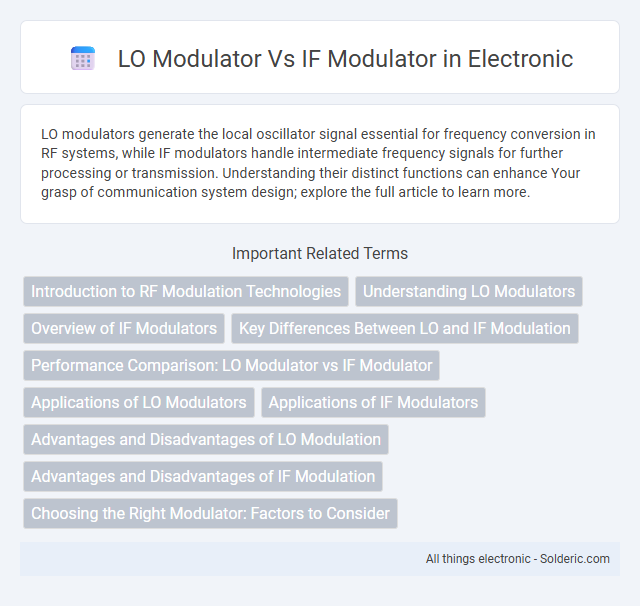LO modulators generate the local oscillator signal essential for frequency conversion in RF systems, while IF modulators handle intermediate frequency signals for further processing or transmission. Understanding their distinct functions can enhance Your grasp of communication system design; explore the full article to learn more.
Comparison Table
| Feature | LO Modulator | IF Modulator |
|---|---|---|
| Function | Generates Local Oscillator signal for frequency mixing | Modulates Intermediate Frequency signal before upconversion |
| Frequency Range | Typically high frequency, near RF carrier frequency | Lower frequency, in the Intermediate Frequency band |
| Signal Processing | Direct frequency synthesis or mixing | Amplitude, phase, or frequency modulation at IF level |
| Complexity | Usually simpler, focused on stable oscillator output | More complex modulation schemes possible |
| Use Cases | Frequency translation and carrier generation in transceivers | Signal modulation prior to final frequency upconversion |
| Output Signal | Unmodulated or frequency-tuned carrier | Modulated IF signal carrying information |
| Advantages | Stable frequency source, low phase noise | Allows advanced modulation formats and signal shaping |
| Disadvantages | Limited to frequency control, no data modulation | Requires additional filtering and processing |
Introduction to RF Modulation Technologies
LO modulators generate the local oscillator signal directly within the RF range, enabling higher frequency stability and simpler upconversion processes for wideband applications. IF modulators operate at intermediate frequencies, allowing easier signal processing and filtering before upconversion to RF, which is advantageous for complex modulation schemes. Your choice between LO and IF modulators depends on system requirements such as frequency range, signal purity, and design complexity.
Understanding LO Modulators
LO modulators generate the local oscillator signal essential for frequency conversion in radio frequency systems, offering precise phase and frequency control for signal modulation. IF modulators, operating at intermediate frequencies, facilitate easier filtering and signal processing before final upconversion or demodulation. Understanding your requirements for signal synthesis and system complexity helps determine whether an LO modulator or IF modulator better suits your application.
Overview of IF Modulators
IF modulators convert baseband signals to intermediate frequency (IF) for easier filtering and improved signal integrity before final upconversion. They offer better spurious suppression and phase noise performance compared to LO modulators, which directly modulate at the local oscillator frequency. IF modulation is widely used in communication systems to optimize signal processing and enhance overall transmitter efficiency.
Key Differences Between LO and IF Modulation
LO modulators generate a local oscillator frequency signal directly used for frequency conversion in RF systems, while IF modulators produce an intermediate frequency signal that requires additional upconversion stages. LO modulators operate at higher carrier frequencies, typically in the GHz range, whereas IF modulators function at lower frequencies, usually in the MHz to low GHz range. The choice between LO and IF modulation impacts system complexity, noise performance, and filter requirements in communication and radar applications.
Performance Comparison: LO Modulator vs IF Modulator
LO modulators generally offer superior phase noise performance and lower spurious emissions compared to IF modulators, making them ideal for high-frequency, high-precision applications. IF modulators provide greater flexibility in signal processing and easier integration with baseband systems but may suffer from increased image rejection challenges and bandwidth limitations. Choosing the right modulator depends on your system's frequency range, linearity requirements, and overall performance goals.
Applications of LO Modulators
LO modulators are essential in radio frequency (RF) systems, particularly for frequency conversion in transmitters and receivers, enabling precise tuning and signal processing. They are widely used in communication systems such as satellite transponders, radar, and software-defined radios where accurate local oscillator signals are crucial. The ability of LO modulators to provide stable and low-phase-noise signals makes them ideal for high-performance wireless and microwave applications.
Applications of IF Modulators
IF modulators are widely used in communication systems where intermediate frequency conversion simplifies signal processing, such as in television broadcasting, radar systems, and satellite communication. These modulators enable efficient frequency translation and filtering, improving signal integrity and system performance in complex RF architectures. Your choice of an IF modulator can enhance overall system flexibility by supporting multi-band operation and easier integration with digital signal processing units.
Advantages and Disadvantages of LO Modulation
LO modulation offers precise frequency control and reduced phase noise compared to IF modulation, enhancing signal integrity in high-frequency applications. Its direct upconversion capability simplifies the transmitter design by eliminating intermediate frequency conversion stages, which can reduce overall system complexity and power consumption. However, LO modulators can suffer from spurious emissions and require high-quality local oscillators, increasing cost and design complexity compared to IF modulators.
Advantages and Disadvantages of IF Modulation
IF modulation offers significant advantages such as improved signal stability and easier filtering at intermediate frequencies, enabling better selectivity and reduced interference compared to baseband signals. However, IF modulators also introduce complexity in the system design and can cause increased power consumption due to additional frequency conversion stages. Your choice depends on whether enhanced signal quality outweighs the trade-offs in system complexity and efficiency.
Choosing the Right Modulator: Factors to Consider
Choosing the right modulator depends on the application's frequency requirements and system complexity. LO modulators typically offer better phase noise performance and frequency stability, making them ideal for high-frequency synthesis and communication systems. IF modulators provide simpler implementation and flexibility for baseband signal processing but may require additional upconversion stages to reach the target RF frequency.
LO modulator vs IF modulator Infographic

 solderic.com
solderic.com